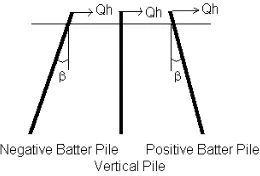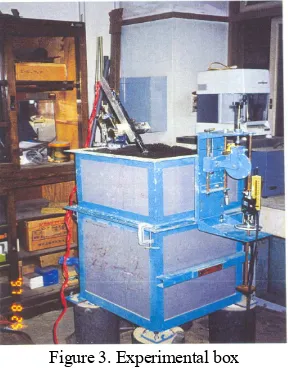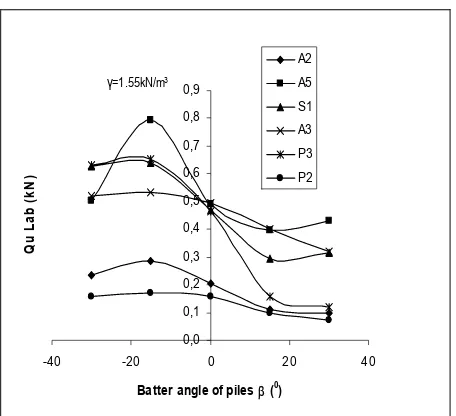Dinamika TEKNIK SIPIL, Akreditasi BAN DIKTI No : 110/DIKTI/Kep/2009 116
B
EHAVIOUROFT
HEU
LTIMATEB
EARINGC
APACITYOFS
INGLEF
LEXIBLEB
ATTERP
ILEU
NDERH
ORIZONTALL
OADS INH
OMOGENEOUSS
ANDP
ERILAKUD
AYAD
UKUNGU
LTIMITT
IANGM
IRINGT
UNGGALF
LEKSIBELD
ENGANB
EBANH
ORIZONTALP
ADAT
ANAHH
OMOGENFabian Johanes Manoppo
Lecturer, Civil Department Faculty of Engineering SamRatulangi University Manado Jl.Kampus Unsrat Bahu Manado 95115 Sulawesi Utara
Email: [email protected]
ABSTRACT
Behaviour of the ultimate bearing capacity of single flexible batter piles in homogeneous sand under horizontal and its applicability is discussed experimentally. Model tests were carried out using instrumented flexible piles of wide-ranging flexi-bilities. The piles were buried in loose, medium and dense homogeneous sand at batter angles = 00, ±150 and±300 were subject-ed to incrementally increasing horizontal loads. The results of model tests on single vertical and batter piles under horizontal loads in homogeneous sand shows that the batter angle ( ) and the unit weight of soil ( ) significantly influenced the ultimate bearing capacity of the piles. Batter angles = -150 or negative batter piles were higher compared then vertical piles and positive batter piles. The proposed value to analysis the ultimate bearing capacity of single flexible batter pile at batter angle = -150 was 25% or 1.25 of the theoretical ultimate bearing capacity under horizontal loads.
Keywords: batter pile, bearing capacity, horizontal load, homogeneous sand
ABSTRAK
Penelitian ini membahas tentang perilaku daya dukung ultimit tiang miring tunggal feksibel dalam tanah homogen dengan beban horizontal dan aplikasinya dengan eksperimen. Pengujian dilakukan dengan menggunakan model tiang dengan berba-gai tingkat fleksibilitas. Tiang ditanam dalam tanah pasir homogen yang lunak, sedang dan padat pada kemiringan β = 00, ±150, ±300 dan diberikan beban yang meningkat secara horizontal. Hasil dari pengujian model tiang tunggal vertikal dan mi-ring yang dibebani secara horizontal pada tanah pasir menunjukkan bahwa sudut kemimi-ringan (β) dan berat volume tanah (γ) memberikan pengaruh yang signifikan pada daya dukung ultimit tiang. Sudut kemiringan β = -150 atau tiang miring negatif mempunyai daya dukung tertinggi dibandingkan tiang vertikal dan tiang miring positif. Pada analisis daya dukung ultimit ti-ang tunggal fleksibel yti-ang miring dengan sudut β = -150 disarankan 25% atau 1,25 dari daya dukung ultimit teoritis dengan beban horizontal.
Kata kunci: tiang miring, daya dukung, beban horizontal, pasir homogen
INTRODUCTION
Batter piles are usually employed when the lateral load ex-ceeds an allowable limit for vertical piles (Mc Nulty, 1956; Peck et al., 1953) and widely used to support lateral loads caused on the foundation of many civil engineering constructions such as bridge abutments, transmission towers, offshore structures and quay walls. Analyses of laterally loaded piles of various stiffnesses in homogeneous elastic soils indicates (Meyerhof, 1979b ; Meyerhof and Yalcin, 1973) that free head piles may be considered as a rigid for practical purposes if their relative stiffness Kr ≥ 0.01 and
flexible piles if their relative stiffness Kr≤ 0.01 . An out batter or a
positive batter pile has horizontal load acting in the opposite direc-tion to the batter, while a negative batter pile has horizontal load acting in the same direction of the batter as shown in Figure1.
Figure 1. General type of vertical and batter piles
Earlier extensive theoretical and experimental studies have been made to analyze the behaviour of single vertical and batter
pi-les in various soils under various loads such as (Award and Petrasovits,1968; Brinch-Hansen,1961; Kubo,1965; Meyerhof and Ranjan,1973; Meyerhof,1979b; Meyerhof et al.,1981; Murthy, 1964; Poulos and Davis,1980; Takahashi,1985; Tschebotarioff, 1953; Meyerhof and Yalcin,1993; Manoppo and Koumoto,1998a; Manoppo and Koumoto,1998b; Sastry et al.,1995). All of the a-bove research was among the contributed on this research.
The aims of this research are to analyze the effect of batter pile and the density of sand in order to increase the ultimate bear-ing capacity of pile under horizontal load. The result of ultimate bearing capacity from laboratory test will be compared with the theoretical ultimate bearing capacity suggested by (Meyerhof and Ranjan 1973).
MODEL TEST
Soil and Pile Data
Sand used in the test was uniformly graded having effect-tive size = 0.12 mm and uniformity coefficient = 1.67. The minimum and maximum void ratios of the sand were 0.61 and 0.96, respectively and the porosity of 47% gave a unit weight of about 14.0 kN/m3 and the friction angle φ=31.00 (Koumoto and Kaku,1988). Based on the above test, for unit weight 15.0 kN/m3 and unit weight 15.5 kN/m3 were given friction angle φ=37.00 and friction angle φ=39.20
.
Assuming isotropy, the values of horizontal modulus elas-ticity of soil Es along the embedded length of pile was back
Dinamika TEKNIK SIPIL/Vol. 10/No. 2/Mei 2010/Fabian Johanes Manoppo/Halaman : 116-119 117 The value of Es was zero at the ground level, and linearly
increasing to a value of 365.000 kN/m2 at a depth of 380 mm. Based on that test the values of Es at unit weight 15.0 kN/m3 and
15.5 kN/m3 are 761.215 kN/m2 and 1376.365 kN/m2. The model piles were made of alumunium, acrylic, hard rubber pipes and steel having an outside diameter B of about 16 mm, 30 mm, 40 mm and wall thickness of 1 to 4 mm. Twelve piles were used. The piles were buried to the length L of 160 mm, 320 mm, 380 mm and 640 mm in sand. The relative pile stiffness Kr ranged
from 69×10-1
to10-5. The details of piles tested are summarized in Table 1.
Table 1. Physical properties of piles
Pile L B d
The experimental setup is shown in Figure 3. Sand was rained and compacted in a square tank 48 × 48 cm and 80 cm depth. When the soil surface reached the required level, the pile was placed at a required batter angle β = 00
, ±150 and ±300 to the vertical. The raining was continued until the tank was full. The horizontal load was applied in 10 to 20 increments, each being 0.0005 to 0.0200 kN depending on the estimated failure load.
Figure 3. Experimental box
The load was applied 20.0 mm and 25.4 mm above the ground level, through a wire passing over a pulley and attached to the pile top. The loading tests results load Q and deflection Y cur-ves are being presented typically in Figure 4.
0
Figure 4. Typically load Q and deflection Y curves
ANALYSIS OF RESULTS
The ultimate bearing capacity of each batter pile from the laboratory test were computed based on fitting method suggested by (Manoppo and Koumoto, 1998a; Manoppo and Koumoto, 1998b). The theory of ultimate bearing capacity Qut of rigid batter
piles was computed using the theory suggested by (Meyerhof and Ranjan, 1973), which assumes the rigid batter pile as a vertical rigid pile subjected to an inclined load,
pressure coefficient on the shaft and δ is friction angle between sand and pile material.
Qn = 0.125 γ B L2 Kb (3)
Qn is the normal capacity, B is the diameter of pile, Kb is the earth
pressure coefficient for pile (Meyerhof, G. G., Mathur, 1981). ε is the angle between the axes of the pile and the load. In the case of the flexible pile the length L is replaced with ultimate effective length Leu by using the equivalent rigid pile method suggested by
(Sastry and Meyerhof, 1994 ). where,
Leu /L= 1.65 Kr0.12 ≤ 1 (4)
Kr=EpIp/EsL4 (5)
Kr is the relative stiffness of piles (Poulos and Davis, 1980), EpIp is
flexural rigidity of pile, Es is horizontal modulus elasticity of soil.
Dinamika TEKNIK SIPIL, Akreditasi BAN DIKTI No : 110/DIKTI/Kep/2009
Figure 5. Typically pile loading test results
The ultimate bearing capacity increased as the sand density increa-sed. This effect is shown in Figure 6.
0
Figure 6. Typically relationship between the unit weight of sand and the ultimate bearing capacity Qu
The conditions of piles after loading, for rigid pile cases, the piles are rotated following the general theory of rigid pile, where that failure of soil are occurred before failure of the pile it self. However, for flexible piles, the yield moment of the pile which may be reached before full mobilization of the ultimate soil re-sistance. The yield moment of the piles roughly occurred at one third of the embedded length L
CONCLUSSION
An analytical investigation was made to determine the ulti-mate bearing capacity of pile loading test results load Q and de-flection Y curves for single flexible batter pile in homogeneous sand under horizontal loads.
The results of model tests on single vertical and batter piles under horizontal loads in homogeneous sand shows that the batter angle ( ) and the unit weight of soil ( ) significantly influence the ultimate bearing capacity of the piles.
The negative batter piles at batter angel ( ) -150 are more resistant to horizontal load than the vertical piles and positive batter piles. On the other hand the theoretical ultimate bearing capacity was given higher at batter angel ( ) -300 because the theory was applied for vertical pile under inclined loads.
The proposed value to compute the ultimate bearing capacity of single flexible batter pile at batter angle = - 150 was 1.25 of the normal or horizontal ultimate bearing capacity Qn.
Although the methods of analysis in this study where shown negative batter piles higher then vertical and positive batter piles, it is believed that further testing of model single batter piles and group piles in the field are needed to verify the proposed concepts.
REFERENCES
Award, A. and Petrasovits, G. (1968). “Considerations on the bearing capacity of vertical and batter piles subjected to forces in different directions.” Proceedings, 3rd Conference on Soil Mechanics, Budapest, pp. 483-497.
Brinch-Hansen, J. (1961). “The Ultimate Resistance of Rigid Pi-les against Transversal Forces.” Geoteknisk Instit., Bull. No. 28, Copenhagen.
Koumoto, T. and Kaku, K. (1988). “On the surface roughness of a cone for sand.” Bulletin No. 65,Faculty of Agriculture, Saga University, Saga 840, Japan.
Kubo, K. (1965). “Experimental study of the behaviour of laterally loaded piles.” Proceedings, 6th International Conference on Soil Mechanics and Foundation Engineering, Montreal, Vol. 2, pp. 275-279.
Manoppo,F.J. and Koumoto,T. (1998a). “Fitting Method for De-termining the Ultimate Bearing Capacity of Flexible Batter Piles in Homogeneous Sand Under Horizontal Loads.” JSIDRE (The Japanese Society of Irrigation Drainage and Reclamation Engineering).
Manoppo,F.J. and Koumoto,T. (1998b). “Fitting Method for Determining the Ultimate Bearing Capacity of Flexible Batter Piles in Clay Under Horizontal Loads.” JSIDRE (The Ja-panese Society of Irrigation Drainage and Reclamation Engi-neering).
McNulty, J. F. (1956). “Thrust Loading on Piles.” Proc. ASCE, 82, No. SM2, pp. 940-1-25.
Meyerhof, G. G. and Ranjan, G. (1973). “The Bearing Capacity of Rigid Piles under Inclined Loads in Sand. II: Batter Piles.”
Canadian Geotechnical Journal, 10, 71-85.
Meyerhof, G. G. (1979b). “Soil-structure interaction and founda-tions.” General Report, 6th Panamerican Conference on Soil Mechanics, Lima, Vol. 1, pp. 109-140.
Meyerhof, G. G., Mathur, S.K. and Valsangkar, A.J. (1981). “Lateral resistance and deflection of rigid walls and piles in layered soils.” Canadian Geotechnical Journal, 18, 159-170. Meyerhof, G. G. and Yalcin, A. S. (1984). “Pile Capacity for
eccentric inclined load in clay.” Canadian Geotechnical Journal, 21, 389-396.
Meyerhof, G. G. and Yalcin, A. S. (1993). “Behaviour of flexible batter piles under inclined loads in layered soil.” Canadian Geotechnical Journal, 30, 247-256.
Murthy, V. N. S. (1964). “Behaviour of batter piles subjected to lateral loads.” PhD Thesis. Indian Institute of Technology, Kharagpur, India.
Peck, R. B., Hansen, W. E. and Thornburn, T. H. (1953). Founda-tion Engineering. John Wiley and Sons, Inc., New York. Poulos, H. G. and Davis, E. H. (1980). Pile foundation analysis
and design. John Wiley & Sons, New York.
Dinamika TEKNIK SIPIL/Vol. 10/No. 2/Mei 2010/Fabian Johanes Manoppo/Halaman : 116-119 119 Sastry, V. V. R. N., Koumoto, T. and Manoppo, F. J. (1995).
“Bearing capacity and bending moment of flexible batter piles in homogeneous soil under horizontal loads.” Bulletin No. 79, Faculty of Agriculture, Saga University, Saga 840, Japan. Takahashi, K. (1985). “Bending of a batter pile due to ground
settlement.” Japanese Society of Soil Mechanics and Founda-tion Engineering, Vol. 40, No. 4, 75-91.


